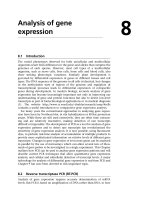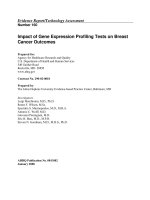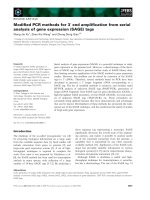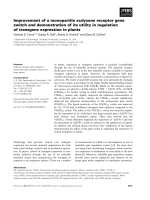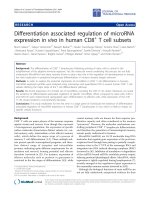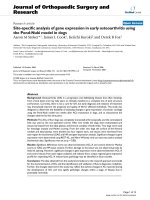Lecture Connections 28 | Regulation of Gene Expression
Bạn đang xem bản rút gọn của tài liệu. Xem và tải ngay bản đầy đủ của tài liệu tại đây (2.9 MB, 58 trang )
Lecture Connections
28 | Regulation of Gene Expression
© 2009 W. H. Freeman and Company
CHAPTER 28
Regulation of Gene Expression
Key topics:
– DNA elements that control transcription
– Protein factors that control transcription
– Lac operon as a model for regulation
– Regulation of protein synthesis by RNA
How to Control Protein’s Activity
in The Cell?
• How much primary RNA transcript to make?
• How to process this RNA into mRNA?
• How rapidly to degrade the mRNA?
• How much protein to make from this mRNA?
• How efficiently to target the protein to its location?
• How to alter the intrinsic activity of this protein?
• How rapidly to degrade the protein?
Processes that Affect Protein’s
Concentration and Activity
DNA Sequences Involved in
Regulation of Gene Expression
• Most bacterial promoters include the conserved
–10 and –35 regions that interact with the
factor of RNA polymerase
• Some promoters also include the upstream
element that interacts with the subunit of RNA
polymerase
Two Main Mechanisms to
Regulate Transcription in Bacteria
• Use of different factors
– These recognize different classes of promoters
– Allows coordinated expression of different sets of genes
• Binding other proteins (transcription factors) to
promoters
– These recognize promoters of specific genes
– These may bind small signaling molecules
– These may undergo post-translational modifications
– The protein’s affinity toward DNA is altered by ligand binding
or post-translational modifications
– Allows expression of a specific genes in response to signals
in the environment
Regulation by Factors
Regulation by Transcription Factors (1)
Regulation by Transcription Factors (2)
• Bound repressor inhibits transcription
Regulation by Transcription Factors (3)
Regulation by Transcription Factors (4)
• Bound activator facilitates transcription
Bacterial Operon
• Operon includes binding sites for activators
and repressors, the promoter to which the
factor binds, and one or more genes whose
expression is controlled by the operon
• In this example, A, B, and C are transcribed as
one polycistronic mRNA that is translated into
three proteins
Lactose Metabolism in E. coli
• When glucose is aplenty and lactose is
lacking, cells make very low levels of
enzymes for lactose metabolisms
• If cells are fed lactose but not glucose, cells
can use it as their energy source given that:
– Lactose is effectively entering the cell
– Lactose is hydrolyzed into
monosaccharides
The lac Operon has Three Sites
for Binding the Lac Repressor
